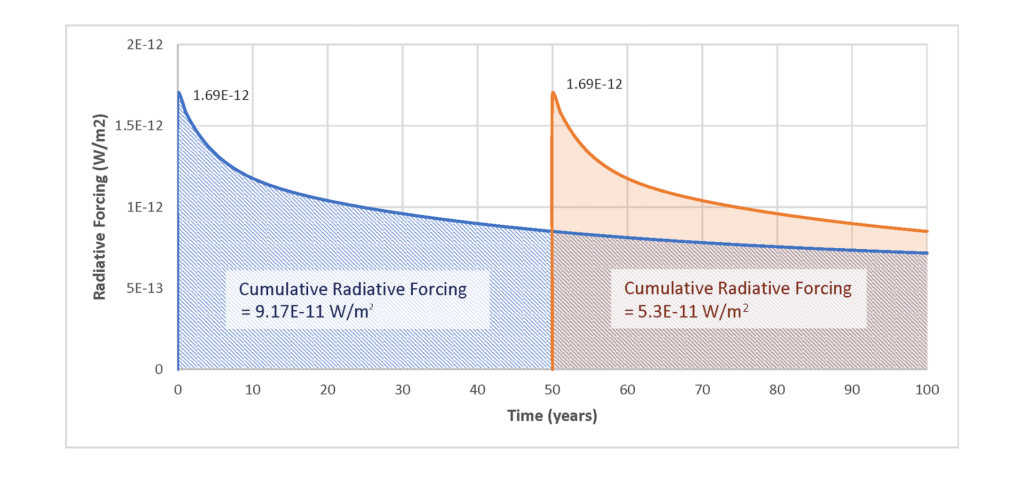Expert Tips
Long-Term Biogenic Carbon Storage
Part 4 in a series on biogenic carbon accounting for wood products—covers long-term carbon storage and delayed emissions, and recommendations for reporting with ISO standards

Note that this is a fairly advanced topic. For an introduction to biogenic carbon, start with the following articles: Calculating the Carbon Stored in Wood Products, When to Include Biogenic Carbon in an LCA, How to Include Biogenic Carbon in an LCA , and Biogenic Carbon Accounting in WBLCA Tools.
Throughout their life cycles, wood products store biogenic carbon that was sequestered from the atmosphere by trees during their growth. At the end of a building’s service life, there are a number of end-of-life scenarios for the wood products, each with a different fate for the stored biogenic carbon:
- When materials are reused or recycled, the biogenic carbon leaves the current product system and is transferred to the next product or building.
- Incineration for energy recovery results in a pulse emission.
- Landfilling results in the slow release of emissions over time (due to partial decomposition), while a portion of biogenic carbon is stored permanently underground.
In all cases, there is a biogenic carbon removal near the beginning of a wood product’s life, and there might be a partial or complete biogenic carbon emission at the end of the life cycle. There might also be biogenic carbon removals and emissions throughout the life cycle, which are described in Part 2, but the majority of biogenic carbon flows occur near the beginning and the end of the product’s life.
Part 1 of this series discussed how biogenic carbon flows are reported, using a “-1 in/+1 out” approach, per ISO 21390. This is a static approach to including biogenic carbon in a life cycle assessment (LCA) and assumes biogenic carbon removals (carbon uptake in the forest) occur at the same point in time as carbon emissions. As a simplified example, assume you have a building that stores 1,000 kg of biogenic carbon in its wood products. In 100 years, at the end of the building’s life, assume all of that stored biogenic carbon is released back to the atmosphere. In this case, your net biogenic carbon flows are zero (-1,000 kg into the system, +1,000 kg out of the system).1
However, this approach ignores the timing of those removals and emissions. We know that CO2 has a long life (i.e., residence time) in the atmosphere; once it is emitted, it exists in the atmosphere for anywhere from 300 to 1,000 years.2 Every year that CO2 exists in the atmosphere, it has a warming effect, known as radiative forcing. Figure 1 shows the radiative forcing curve for a pulse input of 1,000 kg of CO2 emitted at time zero. This emission initially has a large annual warming impact (i.e., radiative forcing). Over time, some of the CO2 is absorbed by the biosphere—oceans and plant life on Earth—which decreases its annual warming impact. However, even at year 100, the portion of the original emission that remains in the atmosphere continues to have a significant warming effect.

Figure 1: Annual Warming Impact of 1,000 kg CO2
Over its residence time in the atmosphere, the total warming effect of CO2 is known as cumulative radiative forcing. When calculating potential global warming impacts over an assumed period of time (e.g., 100 years), the cumulative radiative forcing indicates that 1,000 kg of CO2 emitted to the atmosphere today has a higher total global warming potential (GWP) than 1,000 kg of CO2 emitted in 50 years. This is demonstrated in Figure 2 where the radiative forcing curve from Figure 1 (blue) is overlaid with the radiative forcing curve for 1,000 kg of CO2 emitted in year 50 (orange). The shaded areas represent the cumulative radiative forcing (or total warming effect) for each pulse emission over a 100-year period. The difference between these two areas is the total warming impact that can be avoided by delaying the emission by 50 years. (In this case, the area in blue is about 73% larger than the area in orange indicating that over a 100-year timeframe, a CO2 emission now will have 73% more warming impact than an emission that’s delayed by 50 years.)

Figure 2: Cumulative Warming Impact of 1,000 kg CO2 at Different Times
In the context of whole building life cycle assessment (WBLCA) where we typically look at a building life of 60 to 100 years, it becomes clear that emissions that happen during the production stage (A1-A3), near the beginning of the life cycle, can have much greater impacts than emissions that happen at the end-of-life stage (C1-C4).3
Similarly, removing 1,000 kg of CO2 from the atmosphere today has climate change mitigation benefits over removing 1,000 kg of CO2 in 50 years. In other words, wood has additional climate benefits due to early carbon removal, long-term carbon storage and delayed carbon emissions that are typically excluded from a traditional static LCA approach.
This has been an area of study among scientists for some time—and several methods have been proposed that consider the timing of removals and emissions, and the associated climate impacts. Due to a lack of international consensus on a standardized calculation approach, ISO 21930 does not currently allow for the climate impacts associated with long-term carbon storage and delayed emissions to be quantified and reported as part of the GWP impact indicator. However, it does permit this quantitative or qualitative information to be reported under a category called, “additional environmental information not derived from LCA.” 4
To maintain alignment with current ISO standards, we recommend reporting the amount of biogenic carbon stored in the wood products separately. Keeping a record of this carbon storage allows us to quantify the potential future benefits—for example, biogenic carbon that will continue to be stored if the building’s life is extended or the wood products are reused. It is important to understand and document the amount of carbon that will be withheld from the atmosphere for the life of the building or longer. It is possible that future versions of international standards might include updated quantification methods that will allow for designers to account for the climate benefits associated with long-term carbon storage and delayed emission in the reporting of GWP for wood buildings.
Additional Resources:
CIRAIG. (2010 May). dynCO2: Dynamic Carbon Footprinter.
International Organization for Standardization. (2017). ISO 21930:2017 Sustainability in buildings and civil engineering works – Core rules for environmental product declarations of construction products and services.
Levasseur, A., et al. (2010). Considering Time in LCA: Dynamic LCA and Its Application to Global Warming Impact Assessments. Environmental Science & Technology.
Srubar III, W., et al. (2021). Aureus Earth, Inc. A Methodology for Building-based Embodied Carbon Offsetting.
Moura Costa, P., Wilson, C. (1999). An Equivalence Factor Between CO2 Avoided Emissions and Sequestration – Description and Applications in Forestry. Mitigation and Adaption Strategies for Global Change.
1 For simplicity, this example ignores any biogenic carbon flows that might happen during the operational stage of the building’s life and realistic end-of-life scenarios like permanent sequestration in a landfill or reuse/recycling where some or all of the carbon may never return to the atmosphere.
2 https://climate.nasa.gov/news/2915/the-atmosphere-getting-a-handle-on-carbon-dioxide/
3 Read more about the life cycle stages here.
4 ISO 21930 Section 7.2.9



